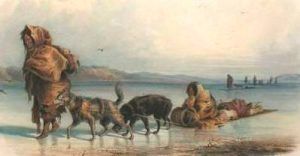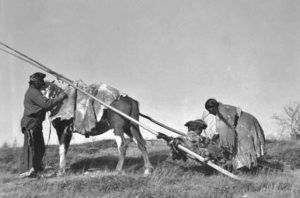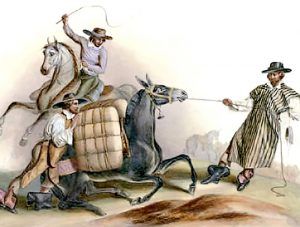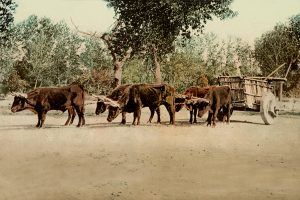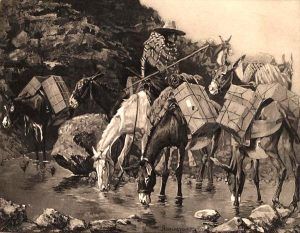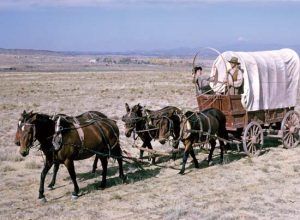By Randall Parrish in 1907
Indian Methods of Transportation
The earliest method of transporting goods across the Plains must have been upon men’s shoulders. Long before Cabeza de Vaca wandered through his 10,000 miles of wilderness in search of Mexico, the Indians of the Plains had taken a step upward and learned to shift their burdens onto the backs of patient dogs. Castaneda, the historian of Coronado’s Expedition to the buffalo plains in 1541, wrote: “They go like Arabs with their tents, and their droves of dogs harnessed with saddle-cloths, pack-saddles, and a cinch. When their load shifts, the dogs howl for someone to straighten it for them.” One hundred years later, another Spanish wanderer, Benavides, wrote:
“I cannot refrain from mentioning something rather incredible and ridiculous: when these Indians go off to trade, the whole rancheros go with their women and children. They live in tents made of buffalo hide, very thin and tanned, and these tents they carry on pack trains of dogs harnessed with their pack saddles. The dogs are medium-sized, and it is customary to have five hundred dogs in one pack train, one in front of another; and thus the people carry their merchandise laden, which they barter for cotton cloth and other things they need.”
By the time the first American adventurers had penetrated beyond the Missouri River, the horse had come to the Indian and been broken to the duties of a burden-bearer. The horse came from the South, gradually overrunning the Plains in wild bands until the Indian tribes as far north as the Missouri River were well supplied. These wild horses were the descendants of those Arabian steeds brought to the New World by the Spanish conquerors of Mexico. As we think of their probable number ranging from the Great Plains as long ago as 1750, it is interesting to note their small beginnings when Cortez 1519 brought the first horses to the mainland of North America. According to the historian Bernal Diaz, the captain had 16 horses and five mares, and he names and describes the latter with care, mentioning the colt born on their voyage from Cuba. And horses had a price in those days in this new land, when the market held firm at a thousand pieces of eight for many a year. But the increase of the stock the Spaniards imported was marvelous, and the prices fell accordingly until, by 1728, horses were down to six dollars each and mules to ten. It was the wild horse, straying from its old-time Mexican owner into the freedom of the wilderness, captured again by the roaming Indian and reduced to slavery, which, almost in a day, lifted the Indian into a new age of development. The Plains tribes knew and used the horse for transportation long before men of English blood wandered into their villages. Yet, their accepted method was highly crude, merely utilizing two sticks attached to the sides of a horse, the ends dragging on the ground. It was the same plan by which they had loaded their dogs. The French called it the “travois,” and its use was universal from the Great Lakes to Texas.
Spanish Methods
The next step in advance of Plains transportation was the pack train of the early Spaniards. The idea was merely an importation from Europe, but its value in the development of the West is beyond computation. The work of the muleteer became almost an art, and there were few regions so isolated, either in mountain or plain, as to remain long unvisited by the pack train. The distance traveled, and the value of merchandise and coins transported in this manner is beyond estimate. In the early history of the Southwest, ordinary commercial routes regularly traveled over 1,500 miles. In 1774, Captain Bautista Anza took such a train from Sonora, Mexico, to San Francisco, California, and Coronado wandered the Plains for nearly two years, a pack train bearing his supplies. On the old Vera Cruz Trail, it is said that 70,000 mules were employed each year, the commerce carried on their backs, reaching a total of $64 million annually. In those days, everything went mule-back, the only concession made to travelers unable to ride in this way being a rude litter on shafts swung to the saddles of two mules walking in single file. Regular commercial routes, over which the pack mules traveled in long columns, were established between Mexico and the border Spanish settlements along the Rocky Mountains, and thus, the pack train was introduced upon the Plains.
As early as the beginning of the 17th century, the first wheeled vehicle appeared in this neighborhood but was probably never used on the Plains outside New Mexico. This was the carreta, built without nails or a scrap of iron, being a rude ox-cart, so heavy that no other motive power could pull it. It had two wheels, made from three sections of Cottonwood logs, fastened to a wooden axle, and without tires. Some carretas were still in use within the memory of living men; their creaking and groaning while in motion imparted to the traveler a sensation never to be forgotten. The first wheeled vehicles ever used within the limits of what is now the United States were those Zacatecas wagons with which Juan de Onate traveled in 1596 in his expedition to colonize New Mexico. We only know oxen hauled them and that fairly regular communication was kept up over the same route for two centuries following.
The Mexican Pack-Train
The first overland commerce established by Americans was along the Santa Fe Trail, and until 1827, it was carried on entirely by pack trains. After that date, wagons were introduced, yet the other method was never wholly abandoned. The Mexican pack train, or “atajo,” adopted by the Americans almost in its entirety, was an institution worthy of description. Henry Inman tells the story as follows:
“A pack mule was termed a mula de carga, and his equipment consisted of several parts; first, the saddle, or aparejo, a nearly square pad of leather stuffed with hay, which covered the animal’s back on both sides equally. The best idea of its shape will be formed by opening a book in the middle and placing it in saddle fashion on the back of a chair. Each half then forms a half of the contrivance. Before the aparejo was adjusted to the mule, a zalea, or raw sheep skin, made soft by rubbing, was put on the animal’s back to prevent chafing, and over it, the saddle cloth, or xerga. On top of both was placed the aparejo, which was cinched by a wide grass bandage. This band was drawn as tightly as possible, to such an extent that the poor brute grunted and groaned under the apparently painful operation, and when fastened, he seemed to be cut in two. This always appeared to be the acme of cruelty to the uninitiated, but it is the secret of successful packing; the firmer the saddle, the more comfortably the mule can travel, with less risk of being chafed or bruised. The aparejo is furnished with a huge crupper, and this appendage is the cruelest of all, for it is almost sure to lacerate the tail. Hardly a Mexican mule in the old days of the trade could be found which did not bear the scar of this rude supplement to the immense saddle.”
The load carried by each mule thus equipped averaged three hundred pounds and was hoisted onto the saddle by two packers, sometimes in a single package, sometimes in two, so prepared to balance themselves. This load, or carga, was secured by a stout rope, drawn as tight as possible under the mule’s belly, and laced around the packs. The operation seldom required more than five minutes. To quote Inman again:
“An old-time atajo, or caravan of pack-mules, generally numbered from 50-200, and it traveled a Jornada or day’s march of about 12-15 miles. This day’s journey was made without stopping at noon because if a pack mule is allowed to rest, he generally tries to lie down, and, with his heavy load, it is difficult for him to get on his feet again. Sometimes, he is badly strained in so doing, perhaps ruined forever. When the train starts on the trail, the mules are so tightly bound with the ropes that they move with great difficulty, but the saddle soon settles itself, and the ropes become loosened so that they must be tightened frequently. On the march, the muleteer is kept busy nearly all the time; the packs are constantly changing their position, frequently losing their balance and falling off; sometimes saddle, pack, and all swing under the animal’s belly, and he must be unloaded and repacked again.”
The cost of such transportation was so low that competition, even by wagons in a level country, was nearly impossible. Mules were almost a drug on the market, and the muleteer received only five dollars a month with rations, the latter merely corn and beans. If he desired meat, he had to hunt for it. On the trail, every employee had his place and duty. Each band of mules was led by a bell mare, with a bell strapped about her neck.
It was part of the party’s cook’s work to lead this bell mare on the march, and the humble pack animals never failed to follow.
After 1824, wagons came into general use for transporting this prairie commerce. They were commonly manufactured in Pittsburg, Pennsylvania, and capable of carrying about a ton and a half. They were usually drawn by eight mules or an equal number of oxen. Later in the trail’s history, much larger wagons were employed, often hauled by as many as 12 animals. The name “prairie schooner was applied to them. The first caravan of wagons to cross the Plains — that experimental trip of 1824 — was drawn by horses and accompanied by a long pack train of mules. Oxen were first used in 1829, and ever after were shared on the Plains, the large Missouri-bred mules necessary for the service were expensive. The cost of outfitting for the long, dangerous journey was considerable. During the height of the trade, the wagons cost 200 dollars each; mules 100 dollars each; harnesses 100 dollars per wagon; water kegs and extras 25 dollars per wagon. As at least ten mules were required for each wagon, the initial cost per wagon was about 1,300 dollars, or for a train of 20 wagons, — as small a number as it was safe to travel with through the Indian country, — 26,000 dollars. Besides this, extra mules had to be taken for use in case of an accident. The wagon master was paid 100 dollars per month, each driver 25 dollars, while there were herders, cooks, and roustabouts to be considered. Altogether, it was a venture of importance, and the ambitious Santa Fe trader had to invest heavily. In the last years of the trade, 200 wagons were on the trail.
Hostility of the Mexican Government to the Traders
For a large part of the time this trade flourished, the Mexican Government was openly hostile to the traders. For several years, westward-bound caravans would halt on the Cimarron River and send scouts forward to ascertain the feelings of the authorities. From the continual changes in administration, “no one knew the nature of their reception in Santa Fe. Under the governorship of Manuel Armijo, a duty of 500 dollars per wagon, whether large or small and regardless of what it contained, was charged against the helpless trader. To offset this robbery, the freight of three wagons was often transferred to one within a few miles of Santa Fe, and the empty vehicles burned. To avoid paying the export duty charged on coins, false axle trees were attached to the wagons, which concealed the money.
Stampedes
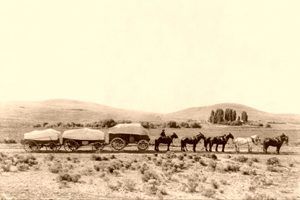
Freight Team on the Plains
During these prairie journeys, the perils of a stampede were dreaded almost more than an Indian attack and probably resulted in greater loss. Night or day, this was a never-absent danger. The mule, a patient, and good worker was as easily frightened as a Texas steer. A prairie dog barking at the entrance of his burrow, a strange figure in the distance, and even the shadow of a passing cloud have been known to start every animal on the train into a wild run. They seemingly go mad, rushing into one another and becoming so entangled that drivers and mules were frequently crushed to death. They have dashed over precipices and been killed or strayed so far away as to be lost in the desert. Inman quotes an incident illustrating this during a winter military campaign in 1868. The mules of three wagons stampeded, dashed out of sight, and were never found. Ten years later, a farmer who had taken up a claim in what is now Rush County, Kansas, discovered in a ravine on his place the bones of some animals, decayed parts of the harness, and the remains of three army wagons. These were undoubtedly the lost stampeders.
The Starting of a Caravan
The starting of one of these great caravans of the Plains on its day’s journey was a scene long to be remembered, the wild and motley aspect of the men fitting accurately into the barren surroundings of the desert and making a vivid picture. “Catch up! Catch up!” is the order of the captain, and instantly, all is uproar and apparent confusion. Josiah Gregg’s description is complete:
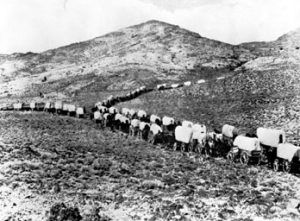
Wagon Train on the Santa Fe Trail
“The uproarious bustle which follows, the hallooing of those in pursuit of animals, the exclamations which the unruly brutes call forth from their wrathful drivers, together with the clatter of bells, the rattle of yokes and harness, the jingle of chains, all conspire to produce an uproarious confusion. It is sometimes amusing to observe the athletic wagoner hurrying an animal to its post — to see him heave upon the halter of a stubborn mule. At the same time, the brute obstinately sets back, determined not to move a peg till his good pleasure thinks it proper to do so. I have more than once seen a driver hitch a harnessed animal to the halter and, by that process, haul his mulishness forward while each of his four projected feet would leave a furrow behind. ‘All’s set!’ is finally heard from some teamster — ‘All’s set!’ is directly responded from every quarter. ‘Stretch out!’ immediately vociferates the captain. Then the ‘heps,’ to the drivers, the cracking of whips, the trampling of feet, the occasional creak of wheels, the rumbling of the wagons, while ‘Fall in!’ is heard from headquarters, and the train is strung out, and in a few moments has started on its long journey.”
Compiled and edited by Kathy Alexander/Legends of America, updated February 2024.
About the Author: This article was written by Randall Parrish as a chapter of his book, The Great Plains: The Romance of Western American Exploration, Warfare, and Settlement, 1527-1870; published by A.C. McClurg & Co. in Chicago, 1907. Parrish also wrote several other books, including When Wilderness Was King, My Lady of the North, Historic Illinois, and others. The text as it appears here, however, is not verbatim, as it has been edited for clarity and ease for the modern reader.
Also See:
List of Old West Explorers, Trappers, Traders & Mountain Men

